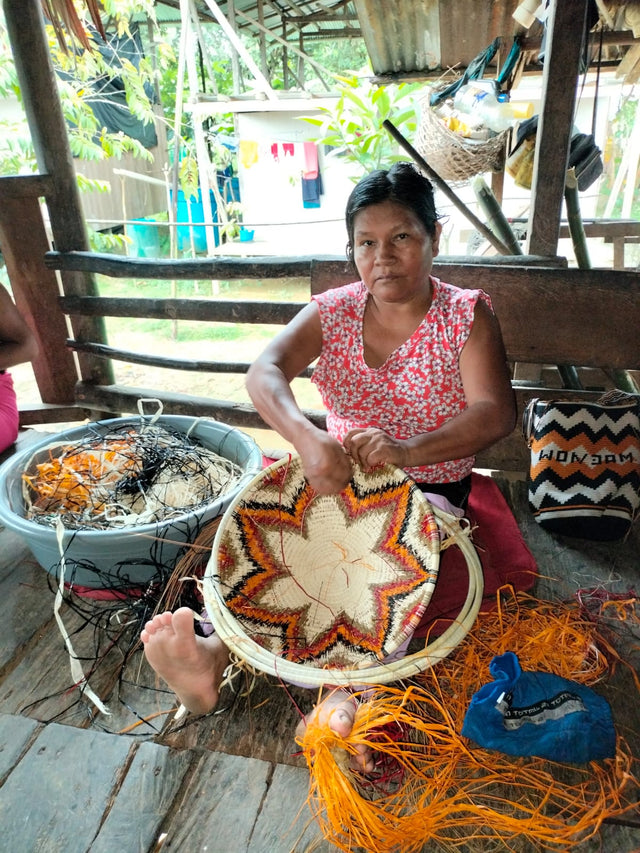
Colombia's Wounaan Werregue Baskets
Werregue baskets, meticulously crafted by the Wounaan Indigenous communities of Colombia’s Pacific region, are celebrated for their bold structure, intricate detail, and deep cultural significance. Colombian Wounaan baskets are identified by their modern designs and shapes, thick coils and wide stitches, most recently weaving with spooled copper wire to create bright shiny designs.
Weavers from villages and cities
Made from the fibers of the Werregue palm, these baskets embody a sustainable approach: young leaves are carefully harvested from the rainforest and treated to enhance their durability for weaving.
The vibrant colors are sourced from natural, local dyes—rich reds from achiote seeds, deep blacks from jagua fruit, and warm yellows from turmeric roots—resulting in a striking yet earthy palette that mirrors the surrounding ecosystem.
A group of weavers, who have been run out of their villages by drug traffickers, are now living as refugees in a new community in Bogota. These weavers have access to different materials, and have added copper wire to their designs for a new bright look.
Maintaining culture as refugees
Supporting the Wounaan community in Colombia is opening the doors to a team of artisan women displaced by violence who, with resilience and work, fight daily to get their families ahead. Their constant struggle to preserve the tradition of their people in exile is an example of permanence and refusal to disappear.
The sale of werregue woven art is a primary source of income for the Wounaan, and has become one of the most important factors in maintaining their culture. For many years they have been threatened with violence and displacement due to internal conflict between the Colombian armed forces, leftist guerrilla groups, and right-wing paramilitary forces. Religious interference, as well as their contact with outside people, have also affected their culture and customs.
 Gilberto
Gilberto


Frequently asked questions
Jen and Ed collaborate closely with skilled weavers and their representatives in each country from which we source our pieces.
Through these direct relationships, we've established meaningful connections with artisans and trusted individuals who represent their countries and tribes with authenticity and respect. Every piece is thoughtfully selected and approved by us personally—whether we bring it back from an in-person visit with the artists or receive it through regular shipments from our trusted partners.

We honor the prices set by the weavers themselves, ensuring that every commissioned basket is truly “fairly traded.”
Our artist-patron approach is built on direct, supportive relationships with weavers and their families, supporting them consistently through the months, and sometimes years, it takes to create each museum-quality basket. We believe that artisans should be compensated promptly for their work, without undue delay.
These skilled weavers are knowledgeable about the value of their craft in U.S. dollars and understand the worth of their time and talent. The growing number of men joining the weaving community shows the art’s increasing value compared to other forms of work. In fact, some weavers now command thousands of dollars for their finest pieces, reflecting the respect and value placed on their craftsmanship.

Purchase woven art because you love it, not simply for its potential to appreciate in value. However, as demand grows for high-quality, handcrafted basketry and supply remains naturally limited, prices have been rising substantially year after year.
We can gain insight into the future value of woven art by looking at trends with vintage and antique Native American baskets, which often fetch thousands to tens of thousands of dollars. A collectible work of art gains value based on market perceptions of its uniqueness, cultural significance, and craftsmanship, both now and in the future.
There is a limited number of skilled weavers capable of producing fine basketry, and even fewer who are true masters of this art. If weaving skills are not passed down through generations, and supplies of raw materials are affected by environmental challenges, previously made baskets could become even more valuable over time.




